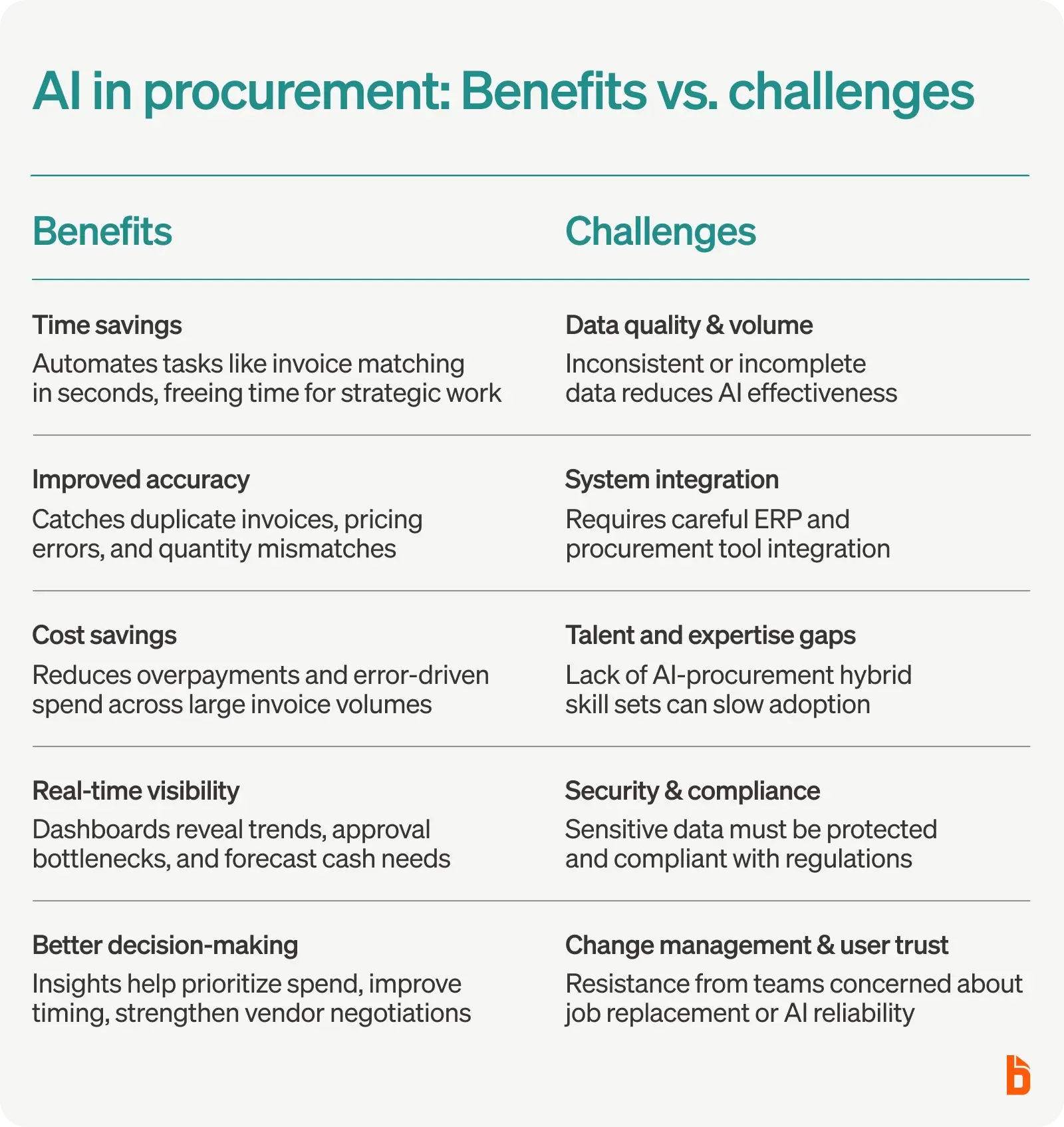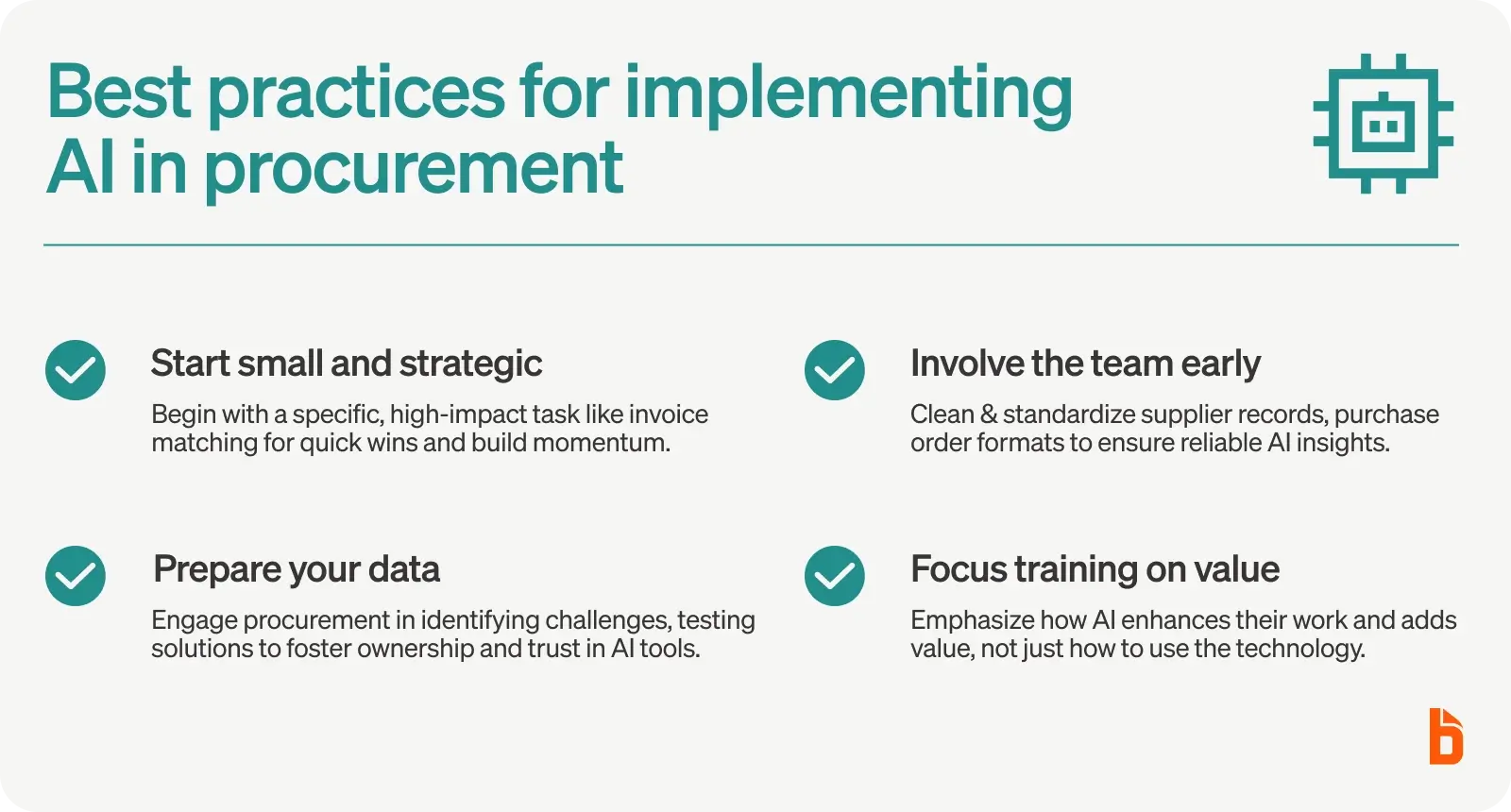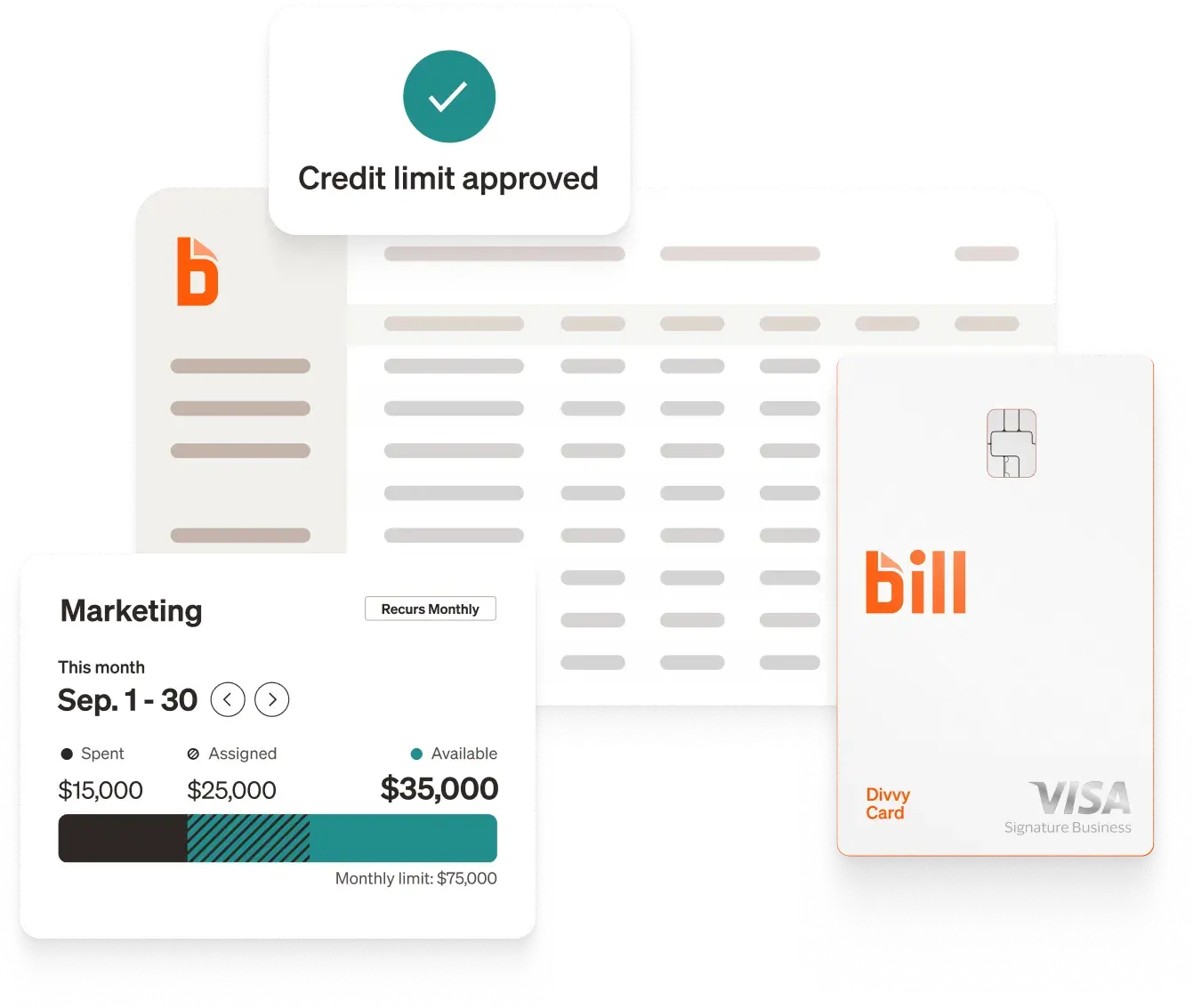Artificial intelligence (AI) is transforming how businesses handle their purchasing processes. From automating repetitive tasks to providing insights that help teams make smarter spending decisions, AI is making procurement faster, more accurate, and less manual than ever before.
This article provides a quick but thorough overview of the types of AI technologies used in procurement, the benefits provided by AI, some common challenges in adopting the technology, and proven strategies for getting the most out of your AI implementation.
What is AI in procurement?
AI in procurement uses intelligent technologies to automate, optimize, and enhance purchasing processes. Instead of manually entering data from purchase orders, matching invoices line by line, or chasing down approvals, AI handles these repetitive tasks while flagging exceptions that need human attention.
For mid-market businesses and accounting firms, this means procurement teams can manage more suppliers and process more transactions without proportionally increasing headcount. The technology acts as an intelligent assistant that learns patterns, suggests improvements, and ensures nothing falls through the cracks.
Types of AI technologies used in procurement
Understanding the different AI technologies used in procurement can help you identify which solutions best fit your needs. Here's a breakdown of the key technologies transforming the way businesses manage their purchasing systems.
Artificial intelligence (AI)
"Artificial intelligence" is an overarching term that encompasses all of the more specific items listed below. It serves as the foundation for all intelligent procurement solutions, enabling these systems to recognize patterns, make predictions, and automate decisions that previously required manual intervention. Think of it as the brain that powers smarter purchasing workflows.
Machine learning (ML)
Machine learning algorithms analyze your historical procurement data to identify trends and predict future needs. They get better over time, learning which suppliers typically deliver on schedule, which purchases often require special approval, and where spending tends to exceed budgets.
Natural language processing (NLP)
NLP helps procurement systems understand and process human language. This technology extracts key information from contracts and emails, powers procurement chatbots that answer supplier questions, and even analyzes communication patterns to gauge supplier relationships.
Robotic process automation (RPA)
RPA handles the repetitive, rule-based tasks that bog down procurement teams. It can automatically route invoices for approval, enter data across multiple systems, and update records when orders are fulfilled—all without human intervention.
Optical character recognition (OCR)
OCR converts paper documents and PDFs into digital, searchable data. When suppliers send paper invoices or contracts, OCR technology reads and digitizes the information, making it instantly available for processing and analysis.
Generative AI
The newest addition to procurement technology, generative AI can draft purchase orders, summarize lengthy contracts into key points, and even help create RFPs based on your requirements. It's like having an experienced procurement professional who can instantly produce first drafts of important documents.
Use cases and applications of AI in procurement
AI transforms everyday procurement operation challenges into automated workflows. When invoices arrive, AI extracts line items, quantities, and costs, then automatically matches them against existing purchase orders. No more manual data entry or line-by-line comparisons.
Approval workflows become intelligent rather than just rule-based. AI recognizes which purchases need executive sign-off, which suppliers require extra scrutiny, and when to fast-track routine orders. It can also flag unusual spending patterns or quantities that deviate from historical norms.
For accounting firms managing multiple clients, AI provides standardized processes across different businesses while still adapting to each client's unique needs. The technology maintains detailed audit trails and ensures consistent application of procurement policies, making it easier to scale services without sacrificing quality.

Benefits of AI in procurement
The most immediate benefit teams often notice is time savings. Tasks that once took hours—like matching multi-line invoices to purchase orders—now happen in seconds. This efficiency gain compounds as AI handles more of the routine work, freeing procurement professionals to focus on vendor relationships and strategic sourcing.
Accuracy improvements can mean cost savings that translate directly to the bottom line. AI can catch duplicate invoices, pricing discrepancies, and quantity mismatches before they result in overpayments. For businesses processing hundreds of invoices monthly, even a small reduction in errors can mean significant savings.
AI also provides visibility that manual processes can't match. Real-time dashboards show spending patterns, highlight bottlenecks in approval workflows, and predict future cash flow needs based on open purchase orders. This insight helps businesses make more informed decisions about when to pay, what to prioritize, and where to negotiate better terms.
Common challenges in AI adoption
While AI offers significant benefits, businesses often encounter hurdles during implementation. Being aware of these challenges can help you plan for and overcome them more effectively.
Data quality and volume requirements
AI systems need clean, consistent data to function effectively. Many businesses discover that their historical procurement data has inconsistencies, missing fields, or varying formats that must be cleaned up before AI can deliver value from that past data, such as year-over-year trends.
Integration with ERP and procurement tools
Getting AI to work seamlessly with existing systems often requires technical expertise and careful planning. The challenge isn't just making systems talk to each other—it's ensuring data flows smoothly and automatically between your ERP and procurement tools, keeping them both up to date.
Talent and expertise gaps
Finding team members who understand both procurement processes and AI technology can be difficult. Many organizations underestimate the learning curve involved in managing AI-powered systems effectively.
Security, privacy, and regulatory concerns
AI systems process sensitive financial data and vendor information. Ensuring this data remains secure while meeting industry regulations requires robust security measures and clear governance policies.
Change management and user trust
Perhaps the biggest challenge is human rather than technical. Procurement teams may worry that AI will replace their jobs or may not trust automated decisions. Building confidence requires transparent communication and implementation.

Best practices for implementing AI in procurement
Start with a specific problem rather than trying to revolutionize everything at once. Choose a high-volume, repetitive task like invoice matching where AI can show quick wins. Success in one area builds momentum and buy-in for broader adoption.
Invest time in data preparation. Clean up supplier records, standardize purchase order formats, and ensure consistent coding across systems. This foundation work may feel tedious, but it determines whether AI delivers insights or confusion, at least when it comes to your historical data.
Include your team from the beginning. Let them help identify pain points and test new workflows. When procurement professionals see AI as a tool that makes their jobs easier rather than a threat, adoption happens naturally. Provide training that focuses on how AI helps them do better work and provide more value, not just how to use new software.
How BILL enhances procurement with AI
BILL Procurement puts AI to work in the areas that matter most to mid-market businesses and accounting firms. The platform uses intelligent automation to extract information from bills, automatically filling in line items, quantities, and cost details directly from your purchase orders. This eliminates manual data entry while ensuring accuracy.
The automated invoice capture uses AI to process invoices as they arrive, maintaining precise, up-to-date information throughout your procure-to-pay workflow. When it's time to pay, BILL's automated 3-way matching compares invoice details against purchase orders, flagging any mismatches that need attention before they become costly errors.
What makes BILL's approach especially valuable is its focus on simplicity. While the AI works behind the scenes to prevent duplicate payments, catch pricing discrepancies, and speed up processing, users experience a clean, intuitive interface that doesn't require technical expertise. For accounting firms, this also means being able to standardize procurement processes across multiple clients while maintaining the flexibility each business needs.
AI in procurement FAQs
If you still have questions about AI in procurement, here are a few answers to some of the most commonly asked questions in the field.
How can AI help with supplier management?
AI transforms supplier relationship management from reactive to proactive. By analyzing supplier databases and historical performance data, AI identifies patterns that help predict which vendors will deliver on time, which might face disruptions, and where relationship issues might arise. This intelligence feeds into spend analysis and spend management decisions, helping procurement teams with supplier risk management, allocating budgets to the most reliable partners while diversifying risk across the supply chain.
Contract management also becomes more strategic when AI extracts and analyzes key terms across all supplier agreements. The technology monitors market trends and benchmarks your contracts against industry standards, flagging opportunities for renegotiation or highlighting when terms fall outside normal ranges. During supplier sourcing, AI can quickly evaluate potential vendors against your specific criteria, comparing capabilities, certifications, and past performance across your industry.
The real power comes from connecting all these insights. AI-driven supply chain management links supplier performance metrics with spend data, contract terms, and market conditions to provide a complete picture. This holistic view helps procurement teams make smarter decisions about which relationships to deepen, where to seek alternatives, and how to optimize their entire supplier ecosystem for both cost efficiency and reliability.
How can AI improve existing procurement systems?
For procurement organizations looking to enhance rather than replace their current systems, AI tools offer a practical path forward. Chief procurement officers don't need to scrap existing investments—instead, AI layers on top of current platforms to unlock new capabilities. By connecting internal data from your ERP and procurement systems with external data like market pricing and supplier insights, AI creates a more complete operational picture without disrupting established workflows.
Advanced analytics powered by AI help procurement leaders identify inefficiencies hiding in plain sight. The technology spots patterns across thousands of transactions that human analysis might miss—from maverick spending to missed early payment discounts. This deeper understanding of operational efficiency enables teams to mitigate risks and refine procurement strategies based on actual performance data rather than assumptions or outdated benchmarks.
The transformation happens gradually but meaningfully. AI enhances decision-making at every level, from tactical choices about which invoices to prioritize to strategic decisions about supplier consolidation. Procurement leaders gain confidence knowing their strategies are backed by comprehensive data analysis, while their teams benefit from streamlined processes that make daily work more manageable and less prone to error.
How can AI apply predictive analytics to procurement?
By combining structured data from enterprise resource planning systems with unstructured data like emails and market reports, AI can analyze past purchasing data alongside historical sales data to forecast future needs. This comprehensive view enables risk mitigation strategies that identify potential risks before they impact operations, whether that's a supplier showing early signs of financial distress or seasonal demand spikes that could strain inventory.
The key to accurate predictions lies in data quality. AI systems must maintain data integrity across all sources to generate reliable data-driven insights. Automated contract analysis helps by extracting critical dates, terms, and obligations that feed into predictive models. When AI flags that multiple contracts are approaching renewal during your busy season, or that a key supplier's performance metrics are declining, procurement teams can act proactively rather than scrambling to respond.
This technology amplifies rather than replaces the procurement team's expertise. While AI excels at processing vast amounts of information and identifying patterns, human judgment remains essential for decision making. Procurement professionals interpret AI predictions within the context of business relationships, strategic goals, and market nuances that algorithms can't fully capture. The combination of AI-powered analytics and human insight creates a procurement function that's both more efficient and more strategic.








